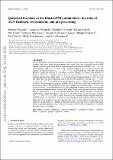Quenched fractions in the IllustrisTNG simulations: the roles of AGN feedback, environment, and pre-processing
Author(s)
Donnari, Martina; Pillepich, Annalisa; Joshi, Gandhali D; Nelson, Dylan; Genel, Shy; Marinacci, Federico; Rodriguez-Gomez, Vicente; Pakmor, Rüdiger; Torrey, Paul; Vogelsberger, Mark; Hernquist, Lars; ... Show more Show less
DownloadAccepted version (1.896Mb)
Open Access Policy
Open Access Policy
Creative Commons Attribution-Noncommercial-Share Alike
Terms of use
Metadata
Show full item recordAbstract
© 2020 The Author(s). We use the IllustrisTNG hydrodynamical simulations to show how the fractions of quenched galaxies vary across different environments and cosmic time, and to quantify the role AGN feedback and pre-processing play in quenching group and cluster satellites. At z = 0, we select galaxies with Mstars = 109-12 M⊙ residing within (≤R200c) massive groups and clusters of total host mass M200c = 1013-15.2 M⊙ in TNG100 and TNG300. The model predicts a quenched fraction of ∼70-90 per cent (on average) for centrals and satellites of mass ≳1010.5 M⊙, regardless of host mass, cosmic time (0 ≤ z ≤ 0.5), cluster-centric distance, and time since infall in the z = 0 host. Low-mass central galaxies (≲ 1010 M⊙), on the other hand, are rarely quenched unless they become members of groups (1013-14 M⊙) or clusters (≥1014 M⊙), where the quenched fraction rises to ∼ 80 per cent. Typically, the fraction of low-mass passive galaxies is higher closer to the host centre and for progressively more massive hosts. The population of low-mass satellites accreted more than ∼ 4-6 Gyr ago in massive hosts is almost entirely passive, thus suggesting an upper limit for the time needed for environmental quenching to occur. In fact, about 30 per cent of group and cluster satellites that are quenched at z = 0 were already quenched before falling into their current host, and the bulk of them quenched as early as 4-10 billion years ago. For low-mass galaxies (Mstars ≲1010-10.5 M⊙), this is due to pre-processing, whereby current satellites may have been members of other hosts, and hence have undergone environmental processes, before falling into their final host, this mechanism being more common and more effective for the purposes of quenching for satellites found today in more massive hosts. On the other hand, massive galaxies quench on their own and because of AGN feedback, regardless of whether they are centrals or satellites.
Date issued
2020Department
MIT Kavli Institute for Astrophysics and Space ResearchJournal
Monthly Notices of the Royal Astronomical Society
Publisher
Oxford University Press (OUP)
Citation
Donnari, Martina, Pillepich, Annalisa, Joshi, Gandhali D, Nelson, Dylan, Genel, Shy et al. 2020. "Quenched fractions in the IllustrisTNG simulations: the roles of AGN feedback, environment, and pre-processing." Monthly Notices of the Royal Astronomical Society, 500 (3).
Version: Author's final manuscript